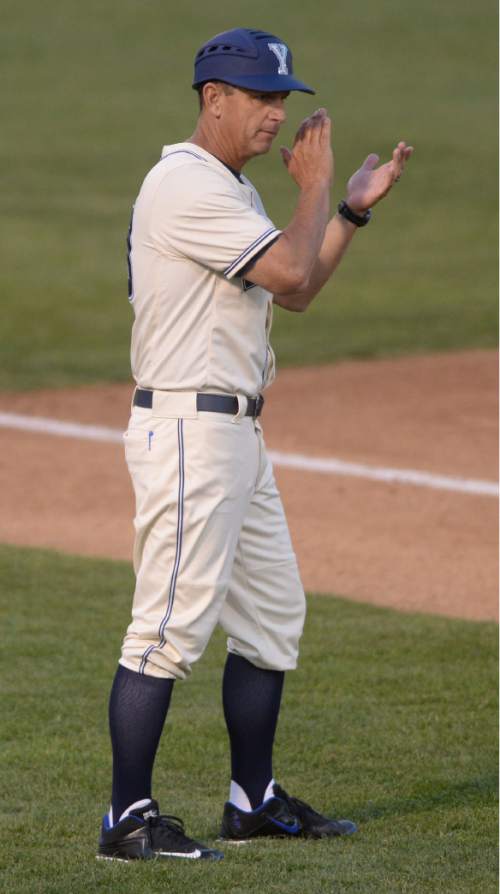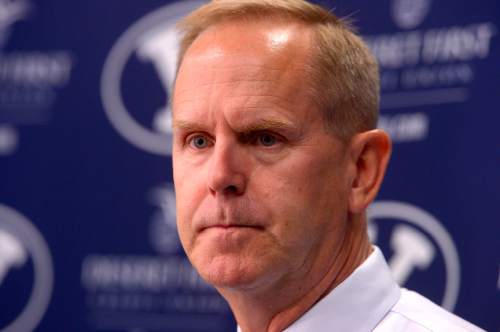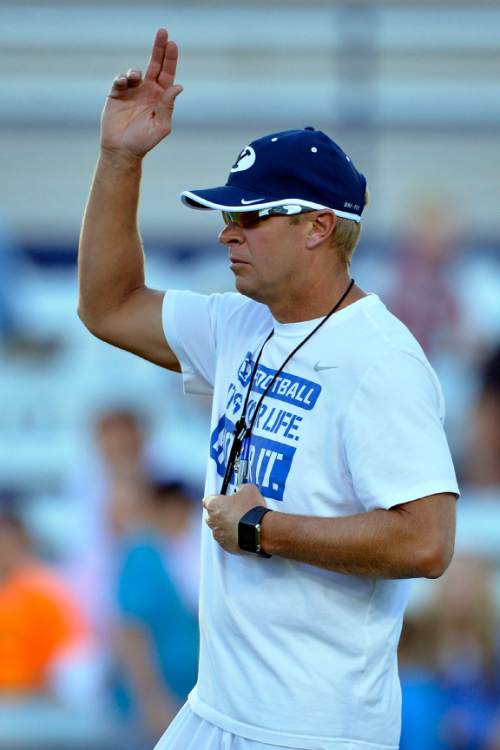This is an archived article that was published on sltrib.com in 2015, and information in the article may be outdated. It is provided only for personal research purposes and may not be reprinted.
Provo • BYU has one of the largest and most successful athletic programs in the country, evidenced by its annual top-50 presence in the Learfield Sports Directors' Cup standings.
However, as BYU officials have made abundantly clear the past few months, the Cougars are not in one of the so-called Power 5 conferences, but would like to be. Still, they plan to keep up with the haves and try to distance themselves from the have-nots when it comes to covering the full cost of attendance for their scholarship student-athletes beginning Aug. 1.
BYU will pay $4,500 per academic year, according to Duff Tittle, associate athletic director for communications. That puts BYU among the top 10 percent of COA-paying schools in the country, BYU football coach Bronco Mendenhall said, referencing data compiled by the Federal Government and the National Center for Education Statistics.
"The data is in, and BYU has one of the highest [COA stipends]," Mendenhall said. "It is actually going to work tremendously in our players' favor."
Several high school athletes who BYU is recruiting corroborated Tittle's dollar figure, saying that is the amount the respective coach in their sport has relayed to them.
"It is really good," baseball coach Mike Littlewood said. "It is quite a bit higher than any other school in the state, I can tell you that. It just shows the commitment that our administration is making to athletics."
The University of Utah will pay $3,574 to its full-ride athletes, $926 less than BYU but more than any other school in the Pac-12, according to figures compiled by the Chronicle of Higher Education. The Chronicle did not report what BYU and other non-Power 5 schools will pay. Utah State has said it will pay about $3,700.
Utah athletic director Chris Hill has said paying COA will cost the school more than $1 million per year; BYU's price tag for COA will likely be much higher, considering Utah has 17 intercollegiate sports and BYU has 21.
A full-ride scholarship generally covers tuition, room and board, and books and fees. The cost-of-attendance stipends, which vary greatly from school to school within the Power 5, per the Chronicle's figures, are designed to cover additional expenses such as travel to and from school, laundry, cell phones, wireless access and more. The bottom line is that the changes will put thousands of dollars more, per year, into student-athletes' pockets.
"And that's a good thing," BYU track and field coach Ed Eyestone said. "They need it."
The other side of the coin is that it will put a serious strain on athletic departments' budgets throughout the country, including BYU's.
BYU officials declined a request to answer specific questions for this report, but athletic director Tom Holmoe said in roundtable discussions with reporters last August and again in February that BYU is prepared to "do what it takes" to stay competitive.
"We are going to do what we do best, and that is compete as hard as we can, with proper funding," Holmoe said. "We will raise a lot of money. We will raise whatever money we need to and do what we need to do. But we are not going to keep up with the Joneses in every single area."
Tittle said BYU has already responded in various ways to the NCAA's deregulation and Power 5 autonomy procedures in providing additional benefits to student-athletes. For instance, BYU increased nutritional opportunities this past school year, he said.
Tittle said BYU officials will publicly address COA and autonomy issues in the near future, but are "not prepared to discuss details at the moment."
In January, 65 representatives and 15 student-athletes from Power 5 conferences voted 79-1 to allow for scholarships that cover full cost of attendance. Boston College, which is a private school, like BYU, voted against it, citing concerns about recruiting advantages some schools could gain by paying higher stipends. BC will pay just $1,400.
It is generally believed that schools must pay COA equally among its male and female scholarship athletes, per Title IX requirements.
Holmoe said last August that the increased costs will not cause BYU to drop any of its sports. Those 21 include roughly 632 student-athletes.
The aforementioned coaches — Mendenhall, Littlewood and Eyestone — said recruits are already starting to ask how much BYU will pay for COA and are comparing it to other schools' promised stipends. Congress has mandated that financial aid offices at every school come up with the figure based on cost-of-living expenses in their area, distance to a major airport, and other factors.
Financial aid offices have some leeway and some might be tempted to cook the numbers, but they do so at the risk of losing federal funding.
Mendenhall and BYU basketball coaches Dave Rose and Jeff Judkins will be able to provide the entire COA amount to their scholarship athletes because theirs are so-called "head-count sports." Other sports at BYU and elsewhere are referred to as "equivalency sports," meaning they have a certain number of scholarships that they have to divide up among their teams.
For instance, Littlewood has 11.7 scholarships (and 11.7 COA stipends) to distribute to his roughly 34 baseball players; Eyestone now has 12.6 full scholarships/COA stipends to disperse to his track team, and so on and so forth.
"I am grateful that BYU took the stance that we are going to do it, even though we are not Power 5," Eyestone said. "It gives us more dollars to work with, a chance to spread the wealth a little bit."
Littlewood said BYU would not have been able to land highly touted San Diego prep baseball phenom Kyle Dean recently without being able to promise a hefty COA amount.
"I am just glad BYU is doing it, because in order to get a Kyle Dean-type guy, you have to be able to give him a big scholarship," Littlewood said. "That's just the nature of the game."
And a sign that BYU is willing to play with the big boys, even if it is not in their league.
Twitter: @drewjay —
Cougars covered
What BYU and Pac-12 schools will pay athletes for cost of attendance:
BYU $4,500
Utah $3,574
Wash. St. $3,542
Arizona St. $3,358
California $3,552
Arizona $3,300
Washington $2,679
Stanford $2,625
UCLA $2,595
Oregon St. $2,484
Oregon $2,340
Colorado $2,294
USC $1,580
Sources: BYU, National Center for Education Statistics, and Chronicle of Higher Education. Online: http://m.chronicle.com/article/At-Least-15-Athletics-Programs/229229/ —
Highly ranked
BYU in Learfield Sports Directors' Cup Standings
Last year
2014-15 34th
2013-14 42nd
2012-13 43rd
2011-12 45th
2010-11 37th
2009-10 36th
Source: http://thedirectorscup.com/











